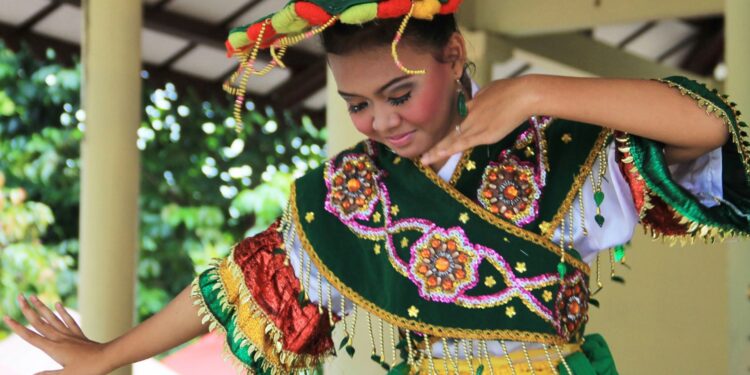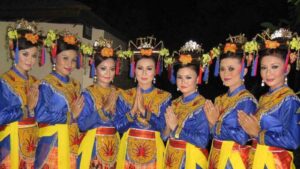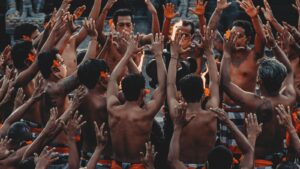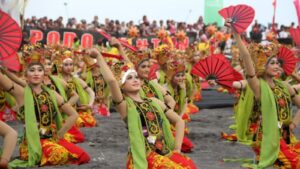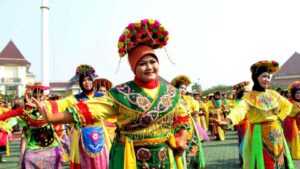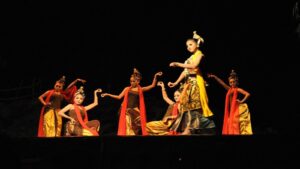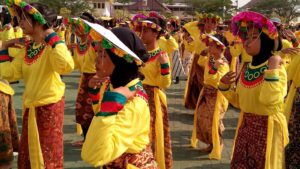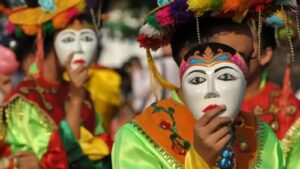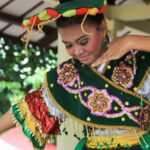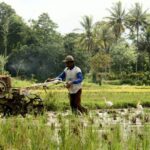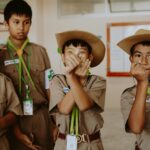The Tari Ronggeng Blantek Berasal Dari isn’t just a dance – it’s a storytelling medium, a vibrant pageantry of Betawi’s rich history. With every move and beat, it paints a vivid picture of the region’s past, making it an integral part of Indonesia’s cultural tapestry.
So, why not join me on this fascinating journey? Let’s explore the origins, the significance, and the unique characteristics of the Tari Ronggeng Blantek Berasal Dari. I promise, it’ll be an experience as dynamic and colorful as the dance itself.
Tari Ronggeng Blantek Berasal Dari Berasal Dari
Tari Ronggeng Blantek Berasal Dari, a traditional Indonesian dance, sprung from the heart of Betawi in Jakarta. It’s not just a dance. It’s a living artifact of history, a vibrant tapestry threaded with the richness of ancestral Indonesian culture. The roots of this dance stretch back to numerous influences ranging from Betawi’s local flavor to a mixture of Arab, Chinese, and Portuguese elements.
From earliest recorded times, the Betawi people expressed their life experiences and societal dynamics through the visual arts. Dance, being an integral part of these expressions, evolved into many vibrant and distinct forms. Among these, Tari Ronggeng Blantek Berasal Dari emerged as a unique manifestation that deeply embodied the region’s varying cultural influences.
Betawi’s merchants and traders often interacted with various communities, leading to an amalgamation of diverse cultural elements. The Tari Ronggeng Blantek Berasal Dari dance subtly exposes such nuances. For instance, the dance steps show a clear influence of Arabic culture, and the tempo mirrors distinct Chinese patterns. The costume is a distinct mosaic of various elements, with Portuguese influence reflected in the vibrant color palette.
The tales of Betawi’s early settlers, their encounters, emotional journeys, and shared experiences, provided fodder for the narratives that Tari Ronggeng Blantek Berasal Dari depicts. Historically, this dance was performed during communal ceremonies and large gatherings. Over the years, it has morphed into a symbol of unity, collective identity, and social resilience.
The dance gained recognition in the larger Indonesian cultural scene only during the early 20th century, despite having been a crucial part of Betawi’s local culture for centuries. It was then that the distinct dance form expanded beyond its regional confines and enchanted audiences with its colorful narrative prowess.
So, the origins of Tari Ronggeng Blantek Berasal Dari are steeped in the convergence of various cultures and practices, setting it apart as a telling symbol of Betawi’s multicultural heritage. It remains a testament to the region’s resilience, adaptability, and absorption of cultural influences, weaving together elements of history, emotion, and tradition into its very fabric.
Significance in Betawi Culture
Taking a deeper look into the core of Tari Ronggeng Blantek Berasal Dari, it’s clear that this dance isn’t simply a form of entertainment, it’s a cornerstone of Betawi culture. Serving as a narrative tool, the dance encapsulates societal dynamics, history, and traditions of the Betawi people.
Indeed, Tari Ronggeng Blantek Berasal Dari is a cultural highlight, reflecting the multicultural roots of Betawi itself. Betawi’s cultural tapestry is intricate, woven with threads from Arab, Chinese, and Portuguese influences. Each of these cultural imprints is detectable in the dance’s movements and rhythms. It’s like watching a history lesson unfold before your eyes!
This dance has long been recognized as a symbol of unity and resilience. Its rise to fame in the broader Indonesian cultural scene during the early 20th century only further cements its significant role. The Tari Ronggeng Blantek Berasal Dari broke barriers, showcasing the diversity and the adaptability of Betawi culture to a wider audience.
Let’s not forget how this dance evolved into an emblem of pride for Betawi. It sprung from the heart of urban Betawi, typically performed at cultural events and celebrations. Today, it’s as much a part of the cultural fabric as any other traditional practice.
The incredible cultural blend embedded within the Tari Ronggeng Blantek Berasal Dari is a testament to Betawi’s multicultural heritage. The dance exemplifies the adaptability of Betawi, absorbing and integrating diverse cultural elements into their societal framework. That’s quite a significant achievement, crystallized in this beautiful, traditional dance form.
And perhaps that’s what I find most fascinating. The Tari Ronggeng Blantek Berasal Dari is not just a dance; it’s a living narrative of Betawi’s multicultural identity. Through their vibrant and dynamic dance, the Betawi people bear testament to their resilient spirit and diverse heritage.
With each performance of Tari Ronggeng Blantek Berasal Dari, it continues to assert its cultural importance within the societal construct of Betawi and by extension, Indonesia. Telling its tales of history, unity, and resilience one performance at a time. It’s a captivating cultural showcase, and it never ceases to amaze onlookers.
Unique Characteristics of the Dance
As we delve into the captivating world of the Tari Ronggeng Blantek Berasal Dari, it’s hard to ignore the dance’s unique characteristics that reflect Betawi’s vibrant multicultural influences. Marked by distinct choreography, elaborate costumes, and animated music, the dance showcases a fascinating blend of raw energy and graceful elegance.
One of the dance’s essential elements is its vivacious rhythm, weaving together the distinct influences of Arabic, Chinese, and Portuguese music. The enchanting musical accompaniment comprises traditional instruments like Gambang Kromong, Tanjidor, and Marawis.
A hallmark feature of the Tari Ronggeng Blantek Berasal Dari is its intricate communication through evocative gestures and expressive movements. The dancers use precise hand movements called ‘tangkis’, combined with eloquent gazes and sways, expertly communicating a narrative that reflects societal themes within Betawi culture.
The lavish costumes provide another window into this cultural saga. The dancers’ attire reflects the vibrant amalgamation of varying cultural influences. This includes the ‘kebayak encim,’ a Chinese-inspired top paired with a local sarong, and the ‘tanjak,’ a traditional Betawi headgear. The dancers’ facial makeup, often dramatic, further highlights the rich blend of cultural incorporation and contemporary influence.
Adding to its uniqueness, the dance often sees an impromptu dialogue between the dancers and the audience. This interactive component of the performance underscores the dance’s role as a cultural bridge, facilitating dialogue and shared experiences between the performers and spectators.
The Tari Ronggeng Blantek Berasal Dari isn’t solely about showcasing the dancer’s physical agility and grace. It has a deeper essence rooted in Betawi’s complex societal fabric. Capturing the soul of the community, it paints a vibrant picture of Betawi’s unique identity and resilience. As we continue to explore this captivating dance, we realize its intricacies mirror the multicultural richness woven into the heart of Betawi’s society. But let’s not overlook the dance’s evolution — how it has transformed over years while staying true to its roots.
Cultural Impact and Preservation
Tari Ronggeng Blantek Berasal Dari plays a profound role in preserving and promoting Betawi’s cultural heritage. For generations, it’s been nurtured and passed down, acting as both a form of entertainment and a medium for historical storytelling. Each twirl, spin, and facial expression narrates a piece of Betawi’s colorful past making it a beautiful treasure trove of culture and history.
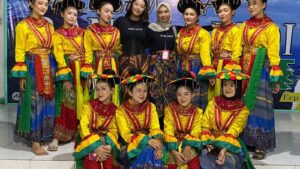
However, the preservation of this dance is critical as traditional art forms worldwide face the risk of fading into oblivion. With rapid urbanization and cultural assimilation, maintaining such traditions has become a pressing concern. As someone who’s witnessed the magic of Tari Ronggeng Blantek Berasal Dari, I firmly believe that every effort should be undertaken to keep this unique tradition alive for future generations.
Lastly, tech-driven platforms are proving to be pivotal in creating a wider reach for traditional art forms. Leveraging platforms like YouTube, Instagram, and Facebook can amplify the visibility of Tari Ronggeng Blantek Berasal Dari, expanding the audience base and fostering appreciation on a global scale.
Tari Ronggeng Blantek Berasal Dari isn’t just a dance. It’s a vibrant encapsulation of Betawi’s history, resilience, and community spirit. Its preservation is vital, not just for maintaining cultural identity but for imparting these values to future generations. The use of digital platforms has proven to be a game-changer, bringing this traditional dance to a global audience.


